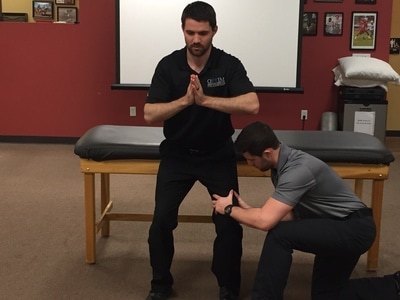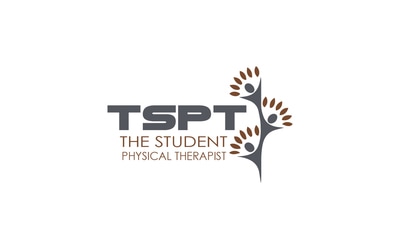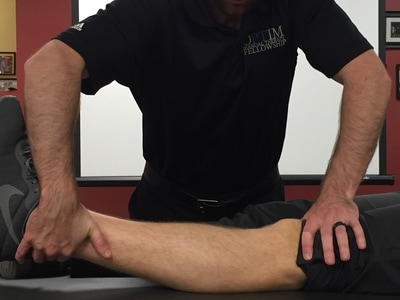- Home
- About Us
- TSPT Academy
- Online Courses
-
Resources
- Newsletter
- Business Minded Sports Physio Podcast
- Day in the Life of a Sports PT
- Residency Corner
-
Special Tests
>
-
Cervical Spine
>
- Alar Ligament Test
- Bakody's Sign
- Cervical Distraction Test
- Cervical Rotation Lateral Flexion Test
- Craniocervical Flexion Test (CCFT)
- Deep Neck Flexor Endurance Test
- Posterior-Anterior Segmental Mobility
- Segmental Mobility
- Sharp-Purser Test
- Spurling's Maneuver
- Transverse Ligament Test
- ULNT - Median
- ULNT - Radial
- ULNT - Ulnar
- Vertebral Artery Test
- Thoracic Spine >
-
Lumbar Spine/Sacroiliac Joint
>
- Active Sit-Up Test
- Alternate Gillet Test
- Crossed Straight Leg Raise Test
- Extensor Endurance Test
- FABER Test
- Fortin's Sign
- Gaenslen Test
- Gillet Test
- Gower's Sign
- Lumbar Quadrant Test
- POSH Test
- Posteroanterior Mobility
- Prone Knee Bend Test
- Prone Instability Test
- Resisted Abduction Test
- Sacral Clearing Test
- Seated Forward Flexion Test
- SIJ Compression/Distraction Test
- Slump Test
- Sphinx Test
- Spine Rotators & Multifidus Test
- Squish Test
- Standing Forward Flexion Test
- Straight Leg Raise Test
- Supine to Long Sit Test
-
Shoulder
>
- Active Compression Test
- Anterior Apprehension
- Biceps Load Test II
- Drop Arm Sign
- External Rotation Lag Sign
- Hawkins-Kennedy Impingement Sign
- Horizontal Adduction Test
- Internal Rotation Lag Sign
- Jobe Test
- Ludington's Test
- Neer Test
- Painful Arc Sign
- Pronated Load Test
- Resisted Supination External Rotation Test
- Speed's Test
- Posterior Apprehension
- Sulcus Sign
- Thoracic Outlet Tests >
- Yergason's Test
- Elbow >
- Wrist/Hand >
- Hip >
- Knee >
- Foot/Ankle >
-
Cervical Spine
>
- I want Financial Freedom
- I want Professional Growth
- I want Clinical Mastery
Treating ACL injuries and returning them to sport involves extensive retraining. Check out a complimentary Insider Access video discussing how to properly implement lateral movement with both progressions and regressions. |
|
Anterior Drawer Test
Purpose: To assess for the integrity of the ACL.
Test Position: Supine.
Performing the Test: Have the patient's tested leg bent to about 90 degrees of flexion. The examiner should sit on the foot of the patient's leg. Place a hand along each side of the patient's knee, while palpating the joint line. Apply a posterior-to-anteriorly directed force through the superior tibia. Compare the involved side to the non-involved side. A positive test includes the lack of an end-feel or excessive translation.
Diagnostic Accuracy: Acute: Sensitivity: .49, Specificity: .58, +LR: 1.4, -LR: .7; Chronic: Sensitivity: .92, Specificity: .91, +LR: 8.9, -LR: .1 ("Clinical diagnosis of an anterior cruciate ligament rupture: a meta-analysis").
Importance of Test: Importance of Test: The anterior cruciate ligament stabilizes against anterior translation of the tibia on the femur, due to the attachment at the anterior tibial plateau and posteriorly on the medial side of the lateral femoral condyle (Neumann 534). The force applied by the examiner stresses the ligament. In the acute stage, this test does not adequately assess the integrity of the ligament due to 3 hypotheses: a) swelling following ACL rupture prohibits the test position of 90 degrees of knee flexion b) hamstring protective spasms following injury restricts anterior translation of the tibia c) the posterior horn of the medial meniscus may become blocked by the medial femoral condyle, again blocking anterior translation of the tibia ("Clinical diagnosis of an anterior cruciate ligament rupture: a meta-analysis"). Often with ACL injuries, other tissues and structures can be injured as well. One of the more significant findings recently has been bone contusions with ACL injuries. Look for research on the topic coming out soon!
Note: these tests should only be used by properly trained health care practitioners
Test Position: Supine.
Performing the Test: Have the patient's tested leg bent to about 90 degrees of flexion. The examiner should sit on the foot of the patient's leg. Place a hand along each side of the patient's knee, while palpating the joint line. Apply a posterior-to-anteriorly directed force through the superior tibia. Compare the involved side to the non-involved side. A positive test includes the lack of an end-feel or excessive translation.
Diagnostic Accuracy: Acute: Sensitivity: .49, Specificity: .58, +LR: 1.4, -LR: .7; Chronic: Sensitivity: .92, Specificity: .91, +LR: 8.9, -LR: .1 ("Clinical diagnosis of an anterior cruciate ligament rupture: a meta-analysis").
Importance of Test: Importance of Test: The anterior cruciate ligament stabilizes against anterior translation of the tibia on the femur, due to the attachment at the anterior tibial plateau and posteriorly on the medial side of the lateral femoral condyle (Neumann 534). The force applied by the examiner stresses the ligament. In the acute stage, this test does not adequately assess the integrity of the ligament due to 3 hypotheses: a) swelling following ACL rupture prohibits the test position of 90 degrees of knee flexion b) hamstring protective spasms following injury restricts anterior translation of the tibia c) the posterior horn of the medial meniscus may become blocked by the medial femoral condyle, again blocking anterior translation of the tibia ("Clinical diagnosis of an anterior cruciate ligament rupture: a meta-analysis"). Often with ACL injuries, other tissues and structures can be injured as well. One of the more significant findings recently has been bone contusions with ACL injuries. Look for research on the topic coming out soon!
Note: these tests should only be used by properly trained health care practitioners
References:
Benjaminse A, Gokeler A, van der Schans CP. "Clinical diagnosis of an anterior cruciate ligament rupture: a meta-analysis." The Journal of orthopaedic and sports physical therapy. May 2006; 36(5):267-288.
Neumann, Donald. Kinesiology of the Musculoskeletal System: Foundations for Rehabilitation. 2nd edition. St. Louis, MO: Mosby Elsevier, 2010. 334. Print.
Benjaminse A, Gokeler A, van der Schans CP. "Clinical diagnosis of an anterior cruciate ligament rupture: a meta-analysis." The Journal of orthopaedic and sports physical therapy. May 2006; 36(5):267-288.
Neumann, Donald. Kinesiology of the Musculoskeletal System: Foundations for Rehabilitation. 2nd edition. St. Louis, MO: Mosby Elsevier, 2010. 334. Print.
Copyright © The Student Physical Therapist LLC 2023



